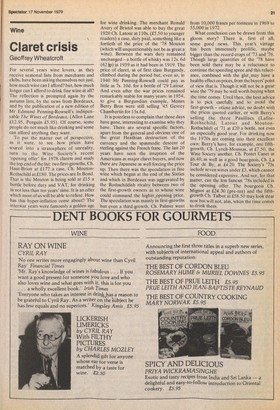Wine
Claret crisis
Geoffrey Wheatcroft
For several years wine lovers, as they receive seasonal lists from merchants and clubs, have been asking themselves not just, how much wine can I afford? but, how much longer can 1 afford to drink fine wine Eit all? The reflection is prompted again by the autumn lists, by the news from Bordeaux, and by the publication of a new edition of Mr Edmund Penning-Rowsell's indispensable The Wines of Bordeaux, (Allen Lane £12.95, Penguin £5.95). Of course, some people do not much like drinking and some can afford anything they want.
To put the matter out of perspective, as it were, to see how prices have soared into a stratosphere of unreality, turn to the Wine Society's recent 'opening offer' for 1978 clarets and study the top end of the list: two first-growths, Ch. Haut-Brion at £177 a case, Ch. MoutonRothschild at £180. The prices are In Bond. That is the Mouton is being sold at £15 a bottle before duty and VAT, for drinking in not less than ten years' time. It is an offer which most of us will be able to refuse. How has this hyper-inflation come about? The interwar years were famously a golden age for wine drinking. The merchant Ronald Avery of Bristol was able to buy the great 1920 Ch. Latour at 110s. (£5.50 to younger readers) a case, duty paid, something like a , fortieth of the price of the '78 Mouton (which will unquestionably not be as great a wine). Between the wars duty remained unchanged —a bottle of whisky was 12s. 6d (62p) in 1939 as it had been in 1919. The price of claret, as of first class Burgundy, climbed during the period but, even so, in 1940 Mr Penning-Rowsell could pay as little as 7s. 10d. for a bottle of '29 Latour. And even after the war prices remained remarkably stable for many years: in 1954, to give a Burgundian example, Messrs Berry Bros were still selling '45 Gevrey Charnbertin for 15s.6d.
It is pointless to complain that those days have gone, interesting to examine why they have. There are several specific factors, apart from the general and obvious one of the great Heathian destruction of the currency and the spasmodic descent of sterling against the French franc. The last 20 years have seen the irruption of the Americans as major claret buyers, and now there are Japanese as well forcing the price up. Then there was the speculation in fine wine which began at the end of the Sixties and which in Bordeaux was aggravated by the Rothschildish rivalry between two of the first-growth owners as to whose wine could command the higher opening price. 'he speculation was mainly in first-growths but even a third-growth, Ch. Palmer went from 10,000 francs per tonneau in 1969 to 55,000 in 1972.
What conclusion can be drawn from this gloom story? There is, first of all, some good news. This year's vintage has been immensely prolific, maybe bigger.than the record crops of '73 and '76. Though large quantities of the '78 have been sold there may be a reluctance to continue the spending spree and this reluctance, combined with the glut ,may have a healthy effect on prices, from the buyers' point of view that is. Though it will not be a great wine the '79 may be well worth buying when the time comes. Until then, the best advice is to pick carefully and to avoid the first-growth — otiose advice, no doubt with the prices quoted earlier, or with Berry's selling the three Pauillacs (LafiteRothschild, Latour and MoutonRothschild) of '71 at £20 a bottle, not even an especially good year. For drinking now the 1970s are coming into their excellent own: Berry's have, for example, one fifthgrowth, Ch. Lynch-Moussas, at £7.50, the Wine Society another, Ch. Pontct Canet at £6.40, as well as a good bourgeois, Ch. La Tour de By, at £4.20. The Society's '73s include seven wines under £3, which cannot be considered expensive. And nor, for that matter, can the less famous '78s included in the opening offer. The bourgeois Ch. Mignot at £24.30 (pre-tax) and the fifthgrowth Ch. Talbot at £58.50 may look dear now but will not, alas, when the time comes to drink them.






































 Previous page
Previous page